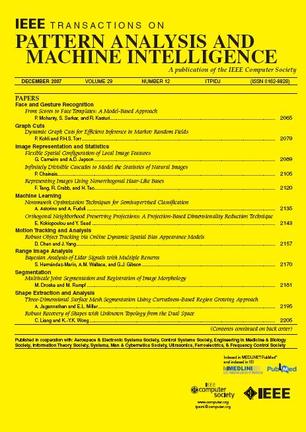OPAL:用于无监督光场视差估计的遮挡模式感知损失
IF 20.8
1区 计算机科学
Q1 COMPUTER SCIENCE, ARTIFICIAL INTELLIGENCE
IEEE Transactions on Pattern Analysis and Machine Intelligence
Pub Date : 2022-03-04
DOI:10.48550/arXiv.2203.02231
引用次数: 3
摘要
光场视差估计是计算机视觉中的一项重要任务。目前,基于监督学习的方法比基于无监督和优化的方法都取得了更好的性能。然而,在没有可用于训练的基本事实的情况下,监督方法对真实世界数据的泛化能力仍然有限。在本文中,我们认为无监督方法不仅可以在真实世界数据上获得更强的泛化能力,而且可以在合成数据集上获得更准确的视差估计结果。为了实现这一目标,我们提出了名为OPAL的遮挡模式感知损失,它成功地提取并编码了光场中固有的一般遮挡模式,用于计算视差损失。OPAL能够:i)通过教导网络如何有效地处理遮挡来实现准确和稳健的视差估计,以及ii)显著减少准确和高效估计所需的网络参数。我们进一步提出了一个EPI变换器和一个基于梯度的细化模块,用于实现更准确和像素对齐的视差估计结果。大量实验表明,与SOTA无监督方法相比,我们的方法不仅显著提高了精度,而且与SOTA有监督方法相比对真实世界数据具有更强的泛化能力。最后,网络训练和推理效率远高于现有的基于学习的方法。我们的代码将公开。本文章由计算机程序翻译,如有差异,请以英文原文为准。
OPAL: Occlusion Pattern Aware Loss for Unsupervised Light Field Disparity Estimation
Light field disparity estimation is an essential task in computer vision. Currently, supervised learning-based methods have achieved better performance than both unsupervised and optimization-based methods. However, the generalization capacity of supervised methods on real-world data, where no ground truth is available for training, remains limited. In this paper, we argue that unsupervised methods can achieve not only much stronger generalization capacity on real-world data but also more accurate disparity estimation results on synthetic datasets. To fulfill this goal, we present the Occlusion Pattern Aware Loss, named OPAL, which successfully extracts and encodes general occlusion patterns inherent in the light field for calculating the disparity loss. OPAL enables: i) accurate and robust disparity estimation by teaching the network how to handle occlusions effectively and ii) significantly reduced network parameters required for accurate and efficient estimation. We further propose an EPI transformer and a gradient-based refinement module for achieving more accurate and pixel-aligned disparity estimation results. Extensive experiments demonstrate our method not only significantly improves the accuracy compared with SOTA unsupervised methods, but also possesses stronger generalization capacity on real-world data compared with SOTA supervised methods. Last but not least, the network training and inference efficiency are much higher than existing learning-based methods. Our code will be made publicly available.
求助全文
通过发布文献求助,成功后即可免费获取论文全文。
去求助
来源期刊
CiteScore
28.40
自引率
3.00%
发文量
885
审稿时长
8.5 months
期刊介绍:
The IEEE Transactions on Pattern Analysis and Machine Intelligence publishes articles on all traditional areas of computer vision and image understanding, all traditional areas of pattern analysis and recognition, and selected areas of machine intelligence, with a particular emphasis on machine learning for pattern analysis. Areas such as techniques for visual search, document and handwriting analysis, medical image analysis, video and image sequence analysis, content-based retrieval of image and video, face and gesture recognition and relevant specialized hardware and/or software architectures are also covered.

 求助内容:
求助内容: 应助结果提醒方式:
应助结果提醒方式:


